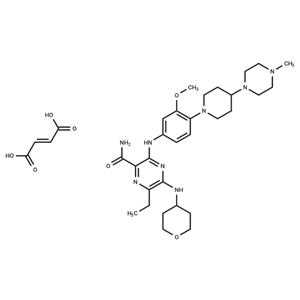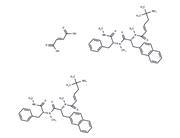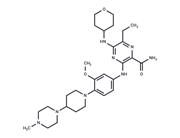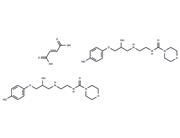| In vitro | Gilteritinib (ASP2215) inhibits FLT3, leukocyte tyrosine kinase (LTK), anaplastic lymphoma kinase (ALK), and AXL kinases by over 50% at 1 nM, with an IC50 value of 0.29 nM for FLT3. It is approximately 800-fold more potent for FLT3 inhibition than for c-KIT[1].
In addition, Gilteritinib inhibits the activity of eight out of 78 tested kinases by over 50% at concentrations of either 1 nM (FLT3, LTK, ALK, and AXL) or 5 nM (TRKA, ROS, RET, and MER). The IC50s are 0.29 nM for FLT3 and 0.73 nM for AXL. The antiproliferative activity of Gilteritinib is evaluated against MV4-11 and MOLM-13 cells, which endogenously express FLT3-ITD. After 5 days of treatment, Gilteritinib inhibits the growth of MV4-11 and MOLM-13 cells with mean IC50s of 0.92 nM (95% CI: 0.23-3.6 nM) and 2.9 nM (95% CI: 1.4-5.8 nM), respectively.
Growth suppression of MV4-11 cells is accompanied by the inhibition of FLT3 phosphorylation. Relative to vehicle control cells, phosphorylated FLT3 levels are 57%, 8%, and 1% after 2 h of treatment with 0.1 nM, 1 nM, and 10 nM Gilteritinib, respectively. Additionally, doses as low as 0.1 nM or 1 nM result in the suppression of phosphorylated ERK, STAT5, and AKT, all downstream targets of FLT3 activation.
To investigate the effects of Gilteritinib on AXL inhibition, MV4-11 cells expressing exogenous AXL are treated with Gilteritinib. At concentrations of 1 nM, 10 nM, and 100 nM for 4 h, Gilteritinib treatment decreases phosphorylated AXL levels by 38%, 29%, and 22%, respectively[2]. |

 United States
United States



